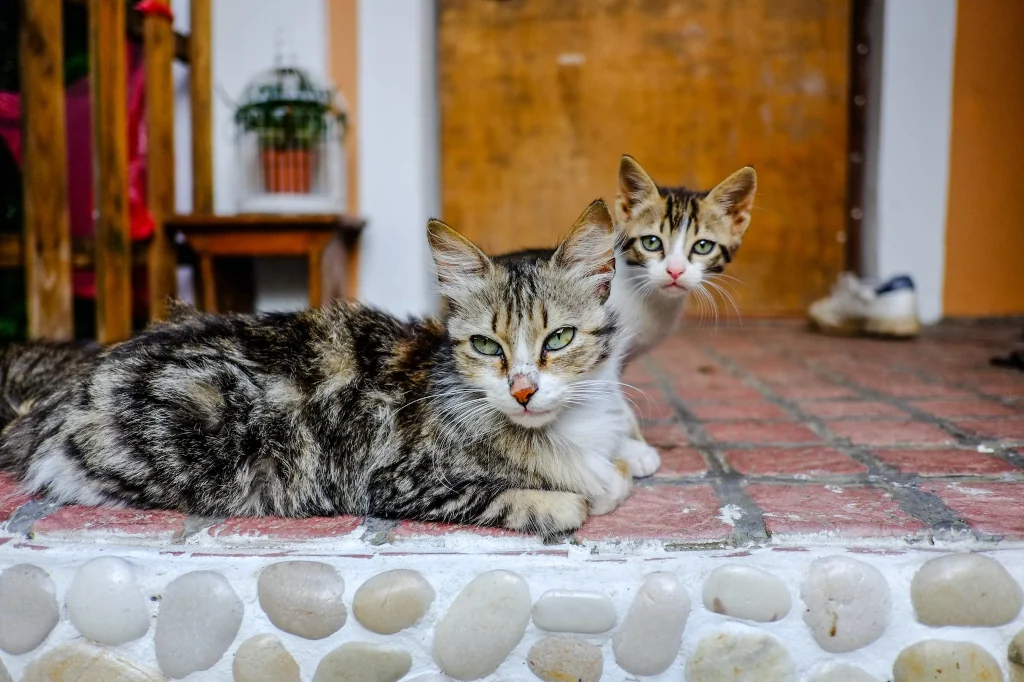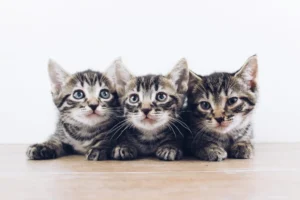Disclosure: We may earn a commission from helpful, relevant links in our content. No cost to you. See our privacy policy.
Ever discovered a mother cat relocating her fuzzy little furballs? It’s a sight that evokes intrigue, admiration, and a touch of worry. Why do they do this, and how far can they take the kittens?
Observing nature, especially the meticulous behavior of mother cats, unfolds stories of survival, care, and strategic brilliance. Dive deeper, and you’ll find layers of reasons, tactics, and even feline quirks that make this seemingly simple act profoundly fascinating.

Why Do Mother Cats Move Their Kittens?
Ah, the intricacies of motherhood!
Just like human moms who would do anything to ensure their kids are safe, mother cats possess an innate protective drive. When a cat becomes a mom, her world changes. Suddenly, there are tiny vulnerable beings depending on her.
The primary reason she moves her kittens is safety. The scent of newborns can attract predators or unwanted attention, making the original birthing spot less secure as days go by.
Moreover, cleanliness is another factor. By changing locations, the mother ensures her kittens stay in a sanitary environment, free from waste and potential pathogens.
Let’s not forget about comfort! As kittens grow, a little more space might be required, prompting a move. So, if you ever witness this act, just know that mama cat is being her best feline self, working tirelessly to protect and care for her little ones.
How Far Will a Cat Usually Move Her Kittens?
When you think of distance, don’t imagine a feline road trip spanning miles!
Mother cats are practical. They aim for safety and minimal disruption. Typically, they would move their kittens within a few feet to several yards from the original spot. It’s often a nearby location that she’s already scouted and deemed safe.
In urban settings, this might mean moving from a quiet corner in the attic to a secluded spot behind the couch, while in the wild, it could be shifting from one shrubbery to another.
Here’s a simple table comparing the distances:
| Environment | Typical Moving Distance | Reason/Condition |
| Urban | From attic to behind a couch | Lees noise, more concealed space |
| Wild | One shrubbery to another | Presence of predators, changing weather |
Mother Nature equipped these feline mothers with a fantastic ability to gauge safety. So while the distance might vary, the underlying goal remains consistent: a secure, clean, and comfortable environment for her precious cargo.
And trust me, these furry moms have their kittens’ best interest at heart, even if their chosen spots sometimes baffle us humans!
How Does a Cat Safely Move Her Kittens from Place to Place?
Oh, the grace and finesse of a mother cat!
If you’ve ever witnessed it, you’d know how mother cats employ a gentle grip to transport their kittens.
They achieve this by clutching the kitten’s nape, also known as the scruff. This action often causes kittens to become passive and relaxed, a reflex that nature has cleverly designed. This technique not only protects the delicate body of the kitten but also ensures a secure grip.
Mother cats are acutely aware of their surroundings. Before the move, they often scout multiple potential spots and even use their whiskers to measure the width of hiding places, ensuring the new location can accommodate her and her litter.
So next time you see your feline friend brushing against places with her whiskers, know there’s more to it than just kitty curiosity!
Can Kittens Travel Long Distances?
The short answer? Not really, especially in their initial weeks.
Kittens are built for short, safe moves under the watchful eye of their mother. In the first few weeks, they are highly dependent, not fully mobile, and their senses are still developing. A long journey could be stressful and potentially harmful.
While there might be rare instances where a mother cat might decide to move her litter over a more extended distance, it’s an exception and not the rule.
When they do venture out on their own, it’s often in the playful bouts of energy that come with kittenhood, but these explorations are usually short-lived and close to home.
How Can You Help Your Cat When She’s Moving Her Kittens?
Stepping into the shoes (or paws!) of a cat mom can be intriguing. While it’s essential to respect the natural instincts of the mother, there are subtle ways you can assist:
- Provide Privacy. Ensure the mother cat has ample privacy during this process. A constant human presence can be distracting or even distressing.
- Safety First. If you know where the new nesting place is, ensure it’s safe. Check for any hazards like sharp objects or substances that might be harmful.
- Offer a Helping Hand… With Caution. If you notice a kitten struggling or left behind, you can assist, but always approach slowly and ensure mama cat is comfortable with your intervention.
- Nutrition Matters. Moving kittens can be taxing. Ensure the mother cat has access to nutritious food to keep her energy levels up.
- Consider Comfort. If the mother cat trusts you, you can place soft blankets or cushions in the new area, offering added comfort for the kittens.
And a final golden nugget of advice: Stay observant but non-intrusive. The balance between aiding and allowing nature to take its course is delicate. Trust the maternal instincts of the cat but be there, in the wings, ready to assist if genuinely needed. After all, it’s a journey of love, protection, and growth – and you’re lucky to witness it!
What Should You Do If You Find Unattended Kittens?
I remember the first time I found a litter in my backyard. The anxiety of not knowing what to do was overwhelming. But with patience and observation, I learned that nature often knows best, and my role was to be a silent observer and helper when truly needed.
Stumbling upon a bundle of furballs might stir our protective instincts, but the situation can be more nuanced than it appears. Here are a few tips to keep in mind:
- Pause and Observe. Before jumping in, take a moment to observe from a distance. It’s not uncommon for mother cats to temporarily leave their kittens to hunt for food. This can last a few hours, so don’t be too hasty.
- Safe Interactions. If you genuinely believe the kittens are orphaned or in danger, use gloves when handling them. This ensures your safety and keeps the kittens’ scent intact, essential if the mother returns.
- Consult a Veterinarian or Rescue. Before deciding on any intervention, it’s always best to consult with a professional. They can guide on feeding, sheltering, and more.
- Unique Insight – The ‘Flour’ Test. Here’s a trick not many know. Sprinkle some flour around the kittens and check later for footprints. This can tell you if the mother is returning to care for them without you noticing.
Related: Why Cats Steal Other Cats’ Kittens
Essential Care Items for Found Kittens
If you find yourself caring for kittens, having a few essentials on hand can be a lifesaver. Here’s a quick list:
- Soft Brush. For gentle grooming. Brands like Hertzko offer self-cleaning options.
- Pet Blanket. Look for those designed specifically for pets to ensure it’s soft and cozy.
- Kitten-Formulated Food. Brands such as Royal Canin have specific formulations for very young kittens.
- Pet-Friendly Gloves. These offer protection while handling and can assist with grooming.
- Kitten Heating Pad. Essential for newborn kittens who can’t regulate their body temperature. The K&H Thermo-Kitty Heated Mat provides gentle heat, perfect for kittens.
- Bottles and Kitten Milk Replacer. If the mother cat isn’t around, these are vital. Look for trusted brands like KMR for milk replacers.
Wrapping things up, remember, nature often has its rhythm. While our hearts want to swoop in and save the day, sometimes the best help is a step back, paired with an observant eye and guided action. For all you cat enthusiasts and accidental kitten-finders, trust in the natural maternal instincts of cats, but always be ready to lend a helping hand when truly necessary.
You’re now well-equipped with knowledge and insights to make those heart-tugging moments count in the best way for our feline friends.
FAQs
How long will a mother cat leave her kittens unattended?
A mother cat may leave her kittens unattended for several hours, usually to hunt or scout for a new location.
Do all mother cats move their kittens?
While not all mother cats relocate their kittens, many do so for safety reasons or environmental changes.
How long does it take for a mother cat to move her kittens?
The duration varies based on distance and circumstances, but typically, a mother cat will move one kitten at a time, taking anywhere from a few minutes to several hours for the entire litter.
Can I move the kittens myself if I think they’re in danger?
If immediate danger is apparent, ensure your safety and then move the kittens to a secure location. However, always consult with a veterinarian or animal rescue professional for further guidance.
Alex, a passionate animal lover, has experience in training and understanding animal behavior. As a proud pet parent to two dogs and three cats, he founded AnimalReport.net to share insights from animal experts and expand his knowledge of the animal kingdom.




